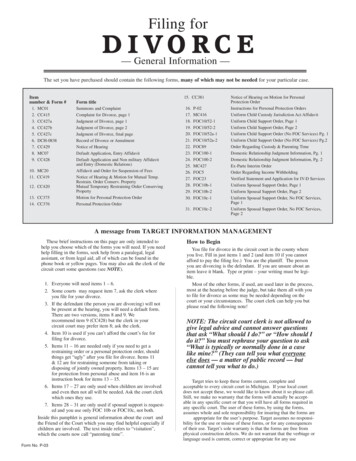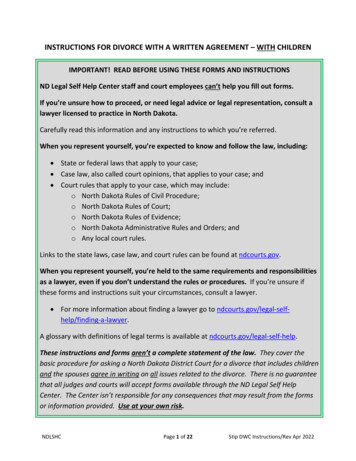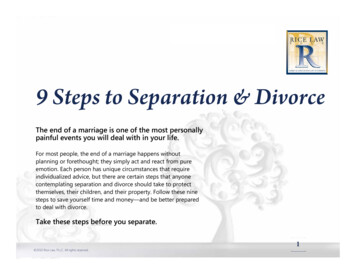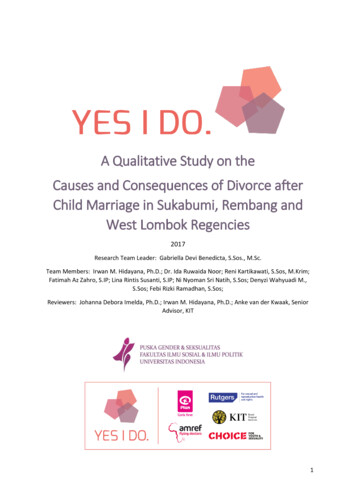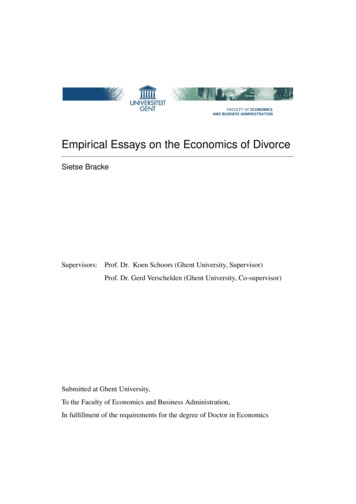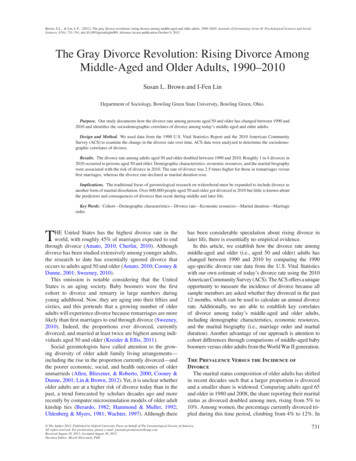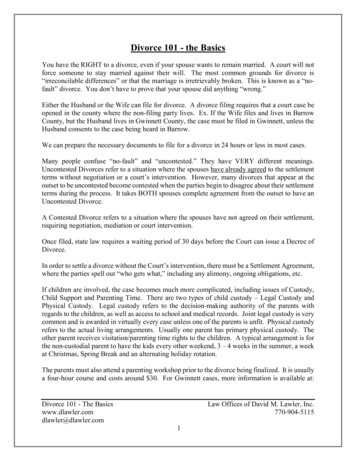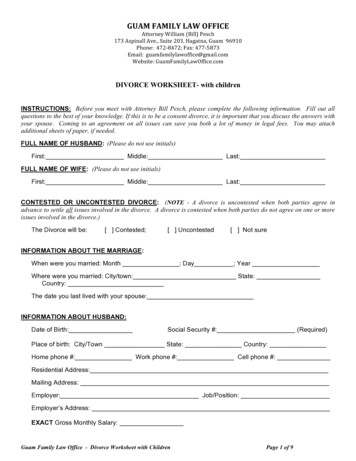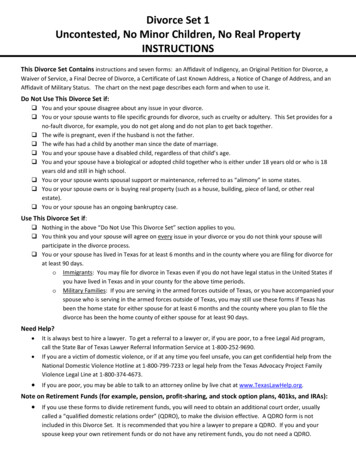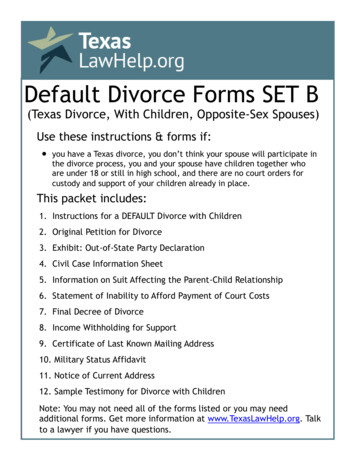
Transcription
Default Divorce Forms SET B(Texas Divorce, With Children, Opposite-Sex Spouses)Use these instructions & forms if: you have a Texas divorce, you don’t think your spouse will participate inthe divorce process, you and your spouse have children together whoare under 18 or still in high school, and there are no court orders forcustody and support of your children already in place.This packet includes:1. Instructions for a DEFAULT Divorce with Children2. Original Petition for Divorce3. Exhibit: Out-of-State Party Declaration4. Civil Case Information Sheet5. Information on Suit Affecting the Parent-Child Relationship6. Statement of Inability to Afford Payment of Court Costs7. Final Decree of Divorce8. Income Withholding for Support9. Certificate of Last Known Mailing Address10. Military Status Affidavit11. Notice of Current Address12. Sample Testimony for Divorce with ChildrenNote: You may not need all of the forms listed or you may needadditional forms. Get more information at www.TexasLawHelp.org. Talkto a lawyer if you have questions.
Instructions for a DEFAULT Divorce with ChildrenThese instructions explain the steps in a default divorce with minor children. Each step includesa link to the form or forms needed for that step.“Default” means you have your spouse served with the initial divorce papers and your spousedoes not file an answer with the court. If your spouse is served and does not file an answer, youcan finish your divorce without your spouse.Use these instructions if: you have a Texas divorce, and you don’t think your spouse will participate in the divorce process, and you and your spouse have children together who are under 18 or still in high school, and there are no court orders for custody and support of your children already in place (other thana family violence protective order). If there is already a final court order for custody and support of your children (not includinga family violence protective order), use this toolkit instead: I need a divorce. We haveminor children. A final custody & support order is already in place. If there is a family violence protective order, use Ask a Question to chat with a lawyer orlaw student about your options. If you were the victim of family violence, you may qualify forfree legal help.Have you read the Frequently Asked Questions and related Articles?These instructions are part of this TexasLawHelp.org toolkit: I need a divorce. We have minorchildren. Before getting started, it’s important to read the Frequently Asked Questions andArticles included in the Toolkit.WARNING! These instructions provide general information and are not a substitute for the adviceand help of a lawyer.Step 1: Determine where to file your divorce.It’s important to file for divorce in the correct county. If you file in the wrong county, your casewill be dismissed and you will lose your filing fee.You can file for divorce in the county where you live or in the county where your spouse livesas long as you or your spouse meets these residency requirements: You can file for divorce in the county where you live as long as: you have lived in that county for at least the last 90 days - and you have lived in Texas for at least the last 6 months. Or, you can file for divorce in the county where your spouse lives as long as: your spouse has lived in that county for at least the last 90 days - and your spouse has lived in Texas for at least the last 6 months.If neither you nor your spouse meets the residency requirements, talk with a lawyer. TexasLawHelp.org – Instructions for a Default Divorce with Children (SET B), July 2017Page 1 of 9
Read the Frequently Asked Questions, FAQs: Filing a Divorce with Children, for additionalinformation.Step 2: Fill out the starting forms.Fill out this starting form: Original Petition for Divorce (Set B) (called the Petition for short)You will file (turn in) the Petition at the courthouse to start your divorce case. The Petitiontells the judge and your spouse that you want a divorce and states what you want the judgeto order in the Final Decree of Divorce. The Frequently Asked Questions and relatedArticles included with these instructions will help you understand your options.When you fill out the Petition: Print your answers neatly in blue or black ink. Do not leave blanks. You are the “petitioner” and your spouse is the “respondent.” Talk to a lawyer if you have questions or need help.Note: The Petition asks for your address. Your spouse will get a copy of the Petition. If youare concerned about your spouse knowing your address, call the Texas Advocacy ProjectHope Line at 1-800-374-HOPE (4673) for free advice.Fill out these additional starting forms if required for your case: Civil Case Information Sheet (required for all cases) Information on Suit Affecting the Family Relationship (required for all cases) Exhibit: Out-of-State Party Declaration (required only if you or your spouse lives outside ofTexas) Statement of Inability to Afford Payment of Court Costs (use only if you cannot afford topay the filing fee for your case) You can call the clerk’s office to learn the filing fee for yourcase. Learn more here: Court Fees and Fee Waivers.Make two copies of these completed starting forms: Petition in Suit Affecting the Parent-Child Relationship Exhibit: Out-of-State Party Declaration (only if you or your spouse lives outside of Texas) Statement of Inability to Afford Payment of Court Courts (only if you are asking the court towaive court costs)Step 3: File (turn in) your starting forms.File (turn-in) your completed Petition and other starting forms with the court. To file your forms online, go to E-File Texas and follow the instructions. To file your divorce forms in person, take the Petition and additional starting forms (andcopies) to the district clerk’s office in the county you have determined is the correct countyto file your divorce. TexasLawHelp.org – Instructions for a Default Divorce with Children (SET B), July 2017Page 2 of 9
At the clerk’s office: Turn in your Petition and other starting forms (and copies). Tell the clerk you want to have your spouse served in person. This means a sheriff,constable or private process server will deliver the initial divorce papers to your spousein person. (Note: If your spouse will agree to sign the necessary court forms, you do notneed to have your spouse served. Follow these instructions instead: Instructions foran Agreed Divorce with Children. Pay the filing fee and issuance fee (or file your completed Statement of Inability toAfford Payment of Court Costs if you cannot afford the fees). You can call the clerk’soffice ahead of time to learn the filing fee for your case. Ask the clerk if there is a local standing order that you need to follow or attach to any ofyour documents. Ask the clerk if there are local rules or procedures you need to know about for yourdivorce. The clerk will write your “Cause Number” and “Court Number” at the top of the first pageof your Petition. (Write these numbers at the top of any document you file in yourdivorce case.) The clerk will “file stamp” your copies with the date and time. The clerk will keep theoriginal and return your copies. The clerk will print a form called a “citation.” The citation tells your spouse that you havefiled for divorce. The citation also tells your spouse that unless he or she files an answerwith the court you will be able to finish your divorce by default (without your spouse).The clerk will attach the other copy of your Petition to the citation. The citation andPetition are the “initial divorce papers” that must be served on your spouse by aconstable, sheriff or private process server. Read Step 4 for instructions.Step 4: Have your spouse served.It is your responsibility to have your spouse served with the initial divorce papers by aconstable, sheriff or private process server. You cannot serve the initial divorce papersyourself.To have your spouse served in person: send the initial court papers to a constable, sheriff or private process server in the countywhere your spouse lives or works; include the service fee (call first to learn the fee) or a file-stamped copy of your Statementof Inability to Afford Payment of Court Costs and a self-addressed and stamped envelope.The constable, sheriff or private process server will: give the initial divorce papers to your spouse, complete a Return of Service form that says when and where your spouse was served, and send the completed Return of Service to you or the court. TexasLawHelp.org – Instructions for a Default Divorce with Children (SET B), July 2017Page 3 of 9
The completed Return of Service is proof your spouse was served. Your spouse will NOT haveto sign anything.If the Return of Service is sent to you, file it at the clerk’s office. The Return of Service must beon file for at least 10 days before you can finish your case, not counting the day it is filed or theday you go to court to finish your case.NOTE: If you have trouble getting your spouse served, read this article: How to Serve theInitial Court Papers. If you have questions, you can use Ask a Question to chat with a lawyeror law student online.Step 5: Notify the Office of the Attorney General (if applicable).Has your child ever received TANF or Medicaid? If NO, skip this step. If YES, you must send a file-stamped copy of your Petition to the Office of the AttorneyGeneral (OAG) Child Support Division (and be able to prove that you did so). Send your Petition by Email - You can scan a file-stamped copy of your Petition and emailit. Find the email address for the OAG child support office in the county where your case isfiled here: Email Addresses for Child Support Offices. Write the cause number and thecounty where you filed your case in the subject line of the email. Print a copy of your email.This is your proof. Bring it with you when you go to court to finish your case. Send your Petition by Certified Mail Return Receipt Requested - Or, you can mail a copy ofyour Petition by certified mail return receipt requested. The post office has the forms forcertified mail return receipt requested. Find the mailing address for the OAG child supportoffice in the county where your case is filed here: Mailing Addresses for Child SupportOffices. The post office will give you a receipt when you mail the Petition. The OAG will signthe return receipt (often called the “green card”) and mail it back to you. This is your proof.Bring the receipt and the return receipt (green card) with you when you go to court to finishyour case.Step 6: Fill out the Final Decree of Divorce and other ending forms.Fill out this Final Decree of Divorce form: Final Decree of Divorce (Set B)You will ask the judge to sign the Final Decree of Divorce form when it’s time to finish yourdivorce. When signed by the judge, the Final Decree of Divorce ends your marriage andmakes orders about your children, property and debt. It may include other orders dependingon your case.The Final Decree of Divorce form must be completely filled out (except for the judge’ssignature) before you go to court. You and your spouse may want to fill out the FinalDecree of Divorce form together.When you fill out the Final Decree of Divorce: Print your answers neatly in blue or black ink. Do not leave blanks. You are the petitioner and your spouse is the respondent. TexasLawHelp.org – Instructions for a Default Divorce with Children (SET B), July 2017Page 4 of 9
Talk to a lawyer if you have questions or need help.Note: A Standard Possession Order form will print with the Final Decree of Divorce form. Ifthis standard possession schedule works for your family, fill it out and attach it to the FinalDecree of Divorce. If it does not work for your family or would not be safe for your children,you can hire a lawyer to write a possession order that meets the specific needs of yourfamily. Or, you may be able to use one of the sample possession orders included with thisarticle: Child Visitation & Possession Orders.Fill out this additional ending form if child support will be ordered Income Withholding for Support OrderNote about retirement benefits: If you are dividing retirement benefits (other than an IRA),you must also complete a form called a Qualified Domestic Relations Order (QDRO).TexasLawHelp.org does not provide QDRO forms. You may contact the employer or retirementplan administrator to see if they have a sample QDRO form. If not, you should hire a lawyer todraft the QDRO form. If you use the employer or plan administrator’s form, you should still havea lawyer review it to make sure you are not giving up important benefits. You should have theQDRO prepared before you go to court, so the judge can sign it when you finish your divorce.Learn more here: Dividing Retirement Benefits upon Divorce - Fact Sheet.Step 7: Have the Final Decree of Divorce form reviewed (if possible).Although not required, it’s a good idea to have a family law lawyer review your completed FinalDecree of Divorce form. You can hire a family law lawyer just to review your forms. This iscalled “limited scope representation.” You may also be able to talk with a lawyer for free at alegal clinic.If you need help finding a lawyer, you can: Use our Legal Help Finder to search for a lawyer referral service, legal aid office or selfhelp center in your area. Check our Legal Clinic Calendar for free legal clinics in your area. Use Ask a Question to chat online with a lawyer or law student.Step 8: Wait the required waiting periods.Wait the waiting periods that apply to your case. 60-day waiting period - In almost all cases, you must wait at least 60 days from the dayyou filed your Original Petition for Divorce before you can finish your divorce in court.You can always wait longer than 60 days, but your divorce cannot be finished in fewer than60 days. When counting the 60 days, find the day you filed your Original Petition for Divorceon a calendar, and then count out 60 more days (including weekends). If the 60th day fallson a weekend or holiday, go to the next business day.Note: Day 1 of the 60 day waiting period is the day after you file your Petition.There are only two exceptions to the 60-day waiting period. TexasLawHelp.org – Instructions for a Default Divorce with Children (SET B), July 2017Page 5 of 9
(1) If your spouse has been convicted of or received deferred adjudication for a crimeinvolving family violence against you or a member of your household, the 60-daywaiting period is waived.(2) If you have an active protective order or an active magistrate’s order for emergencyprotection against your spouse because of family violence during your marriage, the 60day waiting period is waived. 20 day waiting period – From the day your spouse is served, your spouse must have atleast 20 days plus the next Monday at 10:00 a.m. to file an Answer. Find the day yourspouse was served on a calendar, count out 20 more days (including weekends), then goto the next Monday. Your spouse must have until this date to file an answer. If your spousedoes not file an answer by this date (and all other requirements have been met) you canfinish your case by default without your spouse. Note: Your spouse can file an answer untilyou finish your divorce case, even if the 20 day waiting period has passed. 10 day waiting period - The constable, sheriff, or private process server should havecompleted a Return of Service form stating when your spouse was served. The Return ofService form must be on file with the court for at least 10 days before you can finish yourcase. Important: When counting the 10 day waiting period, do not count the day theReturn of Service is filed with the court and do not count the day you go to court to finishyour case.Step 9: Determine if your divorce can be finished by default.Call the clerk’s office to find out if your spouse filed an answer.If your spouse filed an answer, you CANNOT finish your divorce by default. If your spouse filed an answer and will now agree to sign your completed Final Decree ofDivorce, you can finish your case by agreement. If your spouse filed an answer and will not agree to sign your completed Final Decree ofDivorce, your case is contested. To finish a contested divorce, you must set a contestedfinal hearing. You must give your spouse at least 45 days’ notice of the final hearing. Readthis article to learn more: How to Set a Contested Final Hearing (in a Family Law Case).Remember: It’s always best to have a lawyer if your case is contested.If your spouse did NOT file an answer, you CAN finish your divorce by default as long as: your spouse was successfully served by a constable, sheriff or private process server; and a Return of Service form (stating when and where your spouse was served) has been onfile with the clerk’s office for at least 10 days (not counting the day it was filed or the dayyou go to court); and the 20 day waiting period for your spouse to file an answer has passed; and the 60-day waiting period has passed; and your spouse has not filed an answer and does not file an answer before you finish yourdivorce. (Remember, your spouse can file an answer until you finish your divorce, even ifthe 20 day waiting period has passed.) TexasLawHelp.org – Instructions for a Default Divorce with Children (SET B), July 2017Page 6 of 9
If you CAN finish your divorce by default, fill out these additional forms and make one copy ofeach form: Certificate of Last Known Address Military Status Declaration (If your case is filed in Harris County, fill out a Military StatusAffidavit instead. Sign it in front of a notary.) Statement of Evidence (only if your spouse was served by Publication)Step 10: Get ready for court.Call the clerk’s office to learn when and where the court hears uncontested divorce cases.If you sent a copy of your Petition to the Office of the Attorney General (OAG), ask the clerk ifthe OAG filed anything in your case. If no, you can finish your divorce without further notice to the OAG. If yes, talk to a lawyer about what to do next. You can use Ask a Question to chat with alawyer online.Print and read through the sample testimony (found below). You must read this testimony tothe judge when you go to court to finish your divorce. Make sure everything in the sampletestimony is true for you. If not, talk to a lawyer. Remember, everything you say in court mustbe true and correct. You can be charged with a crime for lying in court. Sample Testimony Divorce with Children (Set B)Read the article Tips for the Courtroom for more information about going to Court.Step 11: Go to court to finish your divorce.Bring these papers with you to the courthouse on the day you plan to finish your case: file-stamped copy of your Original Petition for Divorce file-stamped copy of the Return of Service form showing when and where your spouse wasserved the Final Decree of Divorce form completely filled out and signed by you (make sure acompleted possession order is attached) Certificate of Last Known Address form and 1 copy Military Status Declaration (or Affidavit of Military Status for Harris County) and 1 copy Sample Testimony for Divorce with Children (Set B) any additional documents needed for your specific case, such as a Qualified DomesticRelations Order (QDRO) if you are dividing a retirement account.When you get to the courthouse, go to the clerk’s office. Ask the clerk if you need the court file or docket sheet (list of what has been filed in yourcase). TexasLawHelp.org – Instructions for a Default Divorce with Children (SET B), July 2017Page 7 of 9
Ask the clerk to check one more time to see if your spouse has filed an answer. If yourspouse has filed an answer, you will not be able to finish your case by default. Go back toStep 9. File the Certificate of Last Known Address and the Military Status Declaration (or Affidavit ofMilitary Status). Ask the clerk to file stamp your copy of each form. Bring a file-stampedcopy of each form with you to court.When you get to the courtroom tell the clerk you are there and give the clerk your paperwork.Sit down until the judge calls your case.When the judge calls your case, walk to the front of the courtroom and stand in front of thejudge’s bench. The judge will have you raise your right hand and swear to tell the truth. Thejudge may ask you questions or may ask you to read your testimony. Have your sampletestimony ready. The judge will listen to what you say and review your papers. If everything isin order the judge will sign your Final Decree of Divorce.Step 12: File (turn in) the signed Final Decree of Divorce.After the judge signs your Final Decree of Divorce, go back to the clerk’s office. File (turn in) the Final Decree of Divorce and any other orders signed by the judge. Yourdivorce is NOT final until you do so. Get a certified copy of your Final Decree of Divorce and any other orders signed by thejudge. The clerk may charge a fee for the certified copies. If child support was ordered, ask the clerk how to set up a child support account.Step 13: After your divorce is finished.Send a file-stamped copy of your Final Decree of Divorce and any other orders signed by thejudge to your spouse.Follow these additional steps if they apply: If you were ordered to pay child support and/or cash medical support and have questionsabout where to send your payment, you can get information from the Texas AttorneyGeneral Website or by calling 1-(800) 252-8014. If your ex-spouse was ordered to pay child support and/or medical support and doesn’t pay,you can contact the Texas Attorney General Child Support Division for help enforcing yourorder. If your name was changed, take a certified copy of your Final Decree of Divorce to thefollowing agencies: Your local Social Security Administration (SSA) office to change your social securitycard. Your local Department of Public Safety (DPS) office to change your driver’s license orstate identification card. Your County Voter Registrar to change your voter registration card. (For moreinformation, contact the Texas Secretary of State.) TexasLawHelp.org – Instructions for a Default Divorce with Children (SET B), July 2017Page 8 of 9
Contact the U.S. State Department to change your name on your passport. Transfer car titles. If a vehicle (not already in your name alone) is awarded to you, give acertified copy of the Final Decree of Divorce to your county tax office and apply for title. Thevehicle identification number (VIN) must be listed in your divorce decree. File deeds to transfer title to real property (house or land) at the property records office inthe county where the property is located. If the judge signed a QDRO dividing a retirement account, send a certified copy of theQDRO to the administrator of the retirement plan by certified mail return receipt requested.If this isn’t done, you won’t get your share of the retirement funds. Revise your will, insurance policies and all financial account beneficiary designations asneeded. TexasLawHelp.org – Instructions for a Default Divorce with Children (SET B), July 2017Page 9 of 9
NOTICE: THIS DOCUMENT CONTAINS SENSITIVE DATA.Cause Number:(The Clerk’s office will fill in the Cause Number and Court Number when you file this form.)IN THE MATTER OF THE MARRIAGE OFIn the(Court Number)Petitioner:Print first, middle and last name of the spouse filing for divorce.District CourtCounty Court at LawAndCounty, TexasRespondent:Print first, middle and last name of other spouse.AND IN THE INTEREST OF: (List all children you and your spouse have together who are under 18 or still in high school.)1. 2. 3.4. 5. 6.Original Petition for DivorcePrint your answers.My name is: .FirstMiddleLastI am the Petitioner, the person asking for a divorce.The last three numbers of my driver’s license number are: . My driver’s license wasissued in (State) .orI do not have a driver’s license number.The last three numbers of my social security number are: .orI do not have a social security number.My spouse’s name is: .FirstMiddleLastMy spouse is the Respondent.1. Discovery LevelThe discovery level in this case, if needed, is Level 2.2. Legal Notice(Check one box.)I think my spouse will sign a Waiver of Service (or Answer). Do not send a sheriff, constable, orprocess server to serve my spouse with a copy of this Petition for Divorce at this time.I will have a sheriff, constable, process server or clerk serve my spouse with this Petition for Divorcehere:.Street AddressCityStateZipIf this is a work address, name of business: .I ask the clerk to issue a Citation of Service (the form necessary to provide legal notice to my spouse by“Official Service of Process”). I understand that I will need to pay the fee (or file a Statement of Inabilityto Afford Payment of Court Costs if I am unable to pay the fee) and arrange for service.I cannot find my spouse. I ask that my spouse be served by publication. I understand I must file anAffidavit for Citation by Publication and hire a lawyer to serve as attorney ad litem for my spouse.FM-DivB-100 Original Petition for Divorce [SET B] (Rev. 09-2017) TexasLawHelp.orgPage 1 of 10
3. JurisdictionNote: You cannot file for divorce inTexas until you or your spouse haslived in the county where you areasking for a divorce for at least thelast 90 days and in Texas for at leastthe last six months.There are special rules for militaryfamilies and others who are absentfrom the state due to governmentservice. Get more information atwww.TexasLawHelp.org.3A. County Residence Requirement(Check all boxes that apply.)I have lived in this county for the last 90 days.My spouse has lived in this county for the last 90 days.I am serving in the armed forces or other governmentservice outside of Texas, but this county has been thehome county of either my spouse or me for at least 90days.I have accompanied my spouse who is serving inthe armed forces or other government service outside ofTexas, but this county has been the home county of eithermy spouse or me for at least 90 days.3B. Texas Residence Requirement(Check all boxes that apply.)I have lived in Texas for the last six months.Note: If you or your spouse do not live inTexas, you must complete and attach theExhibit: Out-of-State Party Declaration.Get it at www.TexasLawHelp.org.My spouse has lived in Texas for the last six months.I am serving in the armed forces or other government service outside of Texas, but Texas is the homestate of either my spouse or me and has been for at least 6 months.I have accompanied my spouse who is serving in the armed forces or other government service outsideof Texas, but Texas is the home state of either my spouse or me and has been for at least 6 months.3C. Personal Jurisdiction over Spouse(Check one box.)My spouse lives in Texas.My spouse does not live in Texas. (Check any boxes that apply below.)My spouse agrees that a Texas court can make orders in this divorce, including orders regardingconservatorship (custody), visitation, and financial support of our children and orders regarding ourproperty and debts. My spouse will file a Waiver of Service (or Answer).Texas is the last state where we lived together as a married couple. This Petition for Divorce is filedless than two years after we separated.The children live in Texas because of my spouse’s actions.My spouse has lived in Texas with the children.My spouse has lived in Texas and provided prenatal expenses or support for the children.My spouse had sexual intercourse in Texas, and the children may have been conceived by that actof intercourse.Our child was born in Texas and my spouse registered with the paternity registry maintained by thebureau of vital statistics or signed an acknowledgment of paternity.My spouse will be personally served with citation (official service of process) in Texas.FM-DivB-100 Original Petition for Divorce [SET B] (Rev. 09-2017) TexasLawHelp.orgPage 2 of 10
4. Dates of Marriage and SeparationMy spouse and I got married on or about: .MonthDayYearWe stopped living together as spouses on or about: .MonthDayYear5. Grounds for DivorceI ask the Court to grant me a divorce. The marriage has become insupportable due to discord or conflict ofpersonalities that destroys the legitimate ends of the marital relationship and prevents any reasonableexpectation of reconciliation.6. Children6A. Children Husband and Wife have TogetherMy spouse and I are the parents of the following children who are under 18 years old or over 18 years oldand still in high school.(You MUST list all children you and your spouse have together (adopted or biological) who are under 18 or over 18 andstill in high school.)Child’s nameDate of BirthPlace of BirthState where childlives now1.2.3.4.5.6.6B. Jurisdiction over Children(Check one box.)The children live in Texas now and have lived in Texas for at least the past 6 months or since birth.The children do not live in Texas now but they have been gone from Texas less than 6 months. Thechildren lived in Texas the 6 months before they moved. A parent or person acting as a parentcontinues to live in Texas.None of the above apply. (Note: Talk to a lawyer if none of the above apply.)(Check box below only if true.)There are no court orders about any of the children listed above. No other Court has continuingjurisdiction over this case or the children.Note: Do not use this form if there is already a court order in place for any of the children (such as achild support order.). Get informa
Petition are the "initial divorce papers" that must be served on your spouse by a constable, sheriff or private process server. Read Step 4 for instructions. Step 4: Have your spouse served. It is your responsibility to have your spouse served with the initial divorce papers by a constable, sheriff or private process server.
